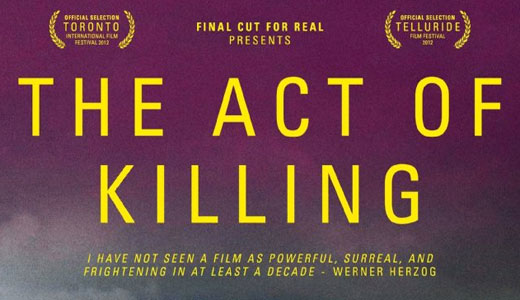
The noted German director Margarethe von Trotta (Rosa Luxemburg) features another powerful woman in her new drama Hannah Arendt. Arendt shocked the world with her controversial concept of “the banality of evil,” describing the demeanor of Nazi war criminal Adolph Eichmann at his 1963 trial that she attended as a journalist. She implied he operated unthinkingly, following orders, efficiently carrying them out, with no consideration of their effects upon those he targeted.
There were some who challenged Arendt’s idea that ordinary people can commit evil acts because they simply follow orders. Some suggest people can become evil when they identify with evil ideology.
Two films screened this year at the Toronto International Film Festival focused on evil, reconciliation, and the tricky process of resolving violent acts of the past. Paul Saltzman’s film “The Last White Knight,” discussed in my previous column, addressed crimes against Southern Blacks and civil rights activists of the 1960s. Viewers are confronted by the genteel mannerisms of Klan leader Delay de la Beckwith. We find ourselves laughing and enjoying his charming Southern drawl and sense of humor, forgetting that his life of hate likely consisted of many horrible deeds against his fellow humans.
“Act of Killing,“ one of the most disturbing films ever made about anti-communism, addressed the killing of millions of alleged communists, ethnic Chinese, and intellectuals in Indonesia in the ’60s.
In the process of making his 2003 film “The Globalization Tapes,” an important worker’s film exposing the role of militarism and repression in building the global economy (the entire film is available free on YouTube), filmmaker Joshua Oppenheimer discovered that the 1965-66 Indonesian massacres were the dark secrets behind the country’s entrance into the global economy. The military’s purpose was to destroy the anti-colonial labor movement to provide cheap labor to foreign investors.
This happened after a military coup deposed President Sukarno and replaced him with the fervent anti-communist General Suharto. A bloodbath ensued and in the next year millions of communists and alleged supporters were viciously killed. This massacre was endorsed by the West and the atrocities were covered up. Sukarno solicited the help of gangsters who formed paramilitary gangs and anti-communist death squads.
After interviewing many of the survivors and hearing unbelievable stories of brutality, Oppenheimer decided to make a movie about the killers, most of whom are officially considered patriots and heroes in their country, with some even enjoying public office, and who boast of their killings.
Oppenheimer came up with a unique filming method, probably one of the only ways to get these mass murderers to participate in the project. Back in the ’60s, one of the fiercest gangsters, Anwar Congo, spent many of his nights in the cinema watching American gangster films. When leaving the theater he would go across the street into the back room of the newspaper building where he tortured and killed dozens of suspected communists. He boasts he has killed hundreds with his own hands.
Congo’s love of cinema drew him to this film, expecting to demonstrate for the camera, in the style of his gangster heroes, the ways in which he killed his victims, usually by wrapping a wire around their necks. It was less bloody and he could kill more efficiently. He and his associates mug to the camera, laugh, and try to imitate the victims’ fears and behavior for the camera.
The gangsters create scenes from famous movies, with singers, dancers, costumes, and props for Oppenheimer to film them killing their victims, American style.
This nightmarish scenario of dream imagery and film style so shocked and impressed veteran filmmakers Erroll Morris and Werner Herzog that they signed on as executive producers. Herzog raved, “I have not seen a film as powerful, surreal, and frightening in at least a decade. It is unprecedented in the history of cinema.”
Indonesia has never come to grips with its crimes against humanity. Before the coup, the Indonesian Communist Party was the largest in the world outside of a communist country. They fought against Dutch colonialism. The mass murders were ignored or covered up by most of the Western media. Today these murderers, death squads and paramilitary movements are still heroes in a land ruled by leaders who would make mass murderer Jeffrey Dahmer blush.
Indonesia’s Pancasila Youth, like a merger between the KKK and Boy Scouts, has a million members including government officials who meet regularly to praise their anti-communist history and brutal tactics. Child rape, torture, and most every unbearable human hate crime is portrayed as matter of fact in “Act of Killing,” where even school children are treated to reenactments of how communists were killed by the death squads.
Oppenheimer has gone into strange new territory here, hoping to offer a cathartic effect for the murderers, several of whom start to question whether their actions were justified. Some start having nightmares, bad memories, and growing guilt. It’s hard for some to play the victim in the film, because they really didn’t know or understand the victims. But here they start to question.
Like South Africa’s Truth and Reconciliation Commission, the process has to start somewhere. Indonesia is a long way from South Africa, but to acknowledge the crimes, humanize the victims, and question purpose and ideology is a beginning. But in a country where the killers won, and built a society around their sickness, it’s hard to imagine. And “Act of Killing” is without a doubt one of the most profound, disturbing, and unimaginable films made in a long time.
Photo: Wikipedia/official film site












Comments